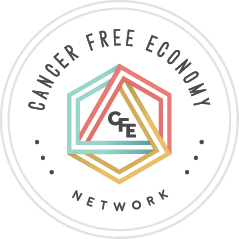Chemicals and Cancer
The International Agency for Research on Cancer has identified hundreds of chemicals that contribute to cancer, and the list is growing.
For breast cancer alone, more than 200 chemicals have been associated with mammary gland tumors in animal studies2Brody, J. G., Moysich, K. B., Humblet, O., Attfield, K. R., Beehler, G. P., & Rudel, R. A. (2007). Environmental pollutants and breast cancer: epidemiologic studies. Cancer, 109(12 Suppl), 2667–2711. https://doi.org/10.1002/cncr.22655 and about half of these are chemicals that women are routinely exposed to in their everyday lives.3Rudel, R. A., Ackerman, J. M., Attfield, K. R., & Brody, J. G. (2014). New Exposure Biomarkers as Tools for Breast Cancer Epidemiology, Biomonitoring, and Prevention: A Systematic Approach Based on Animal Evidence. Environmental health perspectives, 122(9), 881-895. https://doi.org/10.1289/ehp.1307455
Air pollutants has been shown to increase the risk of lung, bladder, liver, breast and other tumor types.4Vermeulen, R., Silverman, D. T., Garshick, E., Vlaanderen, J., Portengen, L., & Steenland, K. (2014). Exposure-response estimates for diesel engine exhaust and lung cancer mortality based on data from three occupational cohorts. Environmental health perspectives, 122(2), 172–177. https://doi.org/10.1289/ehp.1306880.5IARC. (2015). Outdoor air pollution. In IARC monographs on the evaluation of carcinogenic risks to humans 109. Lyon: International Agency for Research on Cancer.6Boothe, V. L., Boehmer, T. K., Wendel, A. M., & Yip, F. Y. (2014). Residential traffic exposure and childhood leukemia: a systematic review and meta-analysis. American journal of preventive medicine, 46(4), 413–422.https://doi.org/10.1016/j.amepre.2013.11.004.7NTP (National Toxicology Program). (2021). Polycyclic Aromatic Hydrocarbons: 15 Listings. In Report on Carcinogens, Fifteenth Edition. Research Triangle Park, NC: U.S. Department of Health and Human Services, Public Health Service. https://doi.org/10.22427/NTP-OTHER-1003
Chemicals, including the now-familiar PFAS used in a variety of products, including non-stick cookware, stain-resistant, waterproof fabrics, and food packaging have been associated with testicular and kidney cancers.8C8 Science Panel. (2020). C8 Probable Link Reports. http://www.c8sciencepanel.org/prob_link.html9Barry, V., Winquist, A., & Steenland, K. (2013). Perfluorooctanoic acid (PFOA) exposures and incident cancers among adults living near a chemical plant. Environmental health perspectives, 121(11-12), 1313–1318. https://doi.org/10.1289/ehp.1306615
Organic solvents such as benzene are potent carcinogens, causing leukemia, non-Hodgkin’s lymphoma, and multiple myeloma.10Lynge, E., Anttila, A., & Hemminki, K. (1997). Organic solvents and cancer. Cancer causes & control : CCC, 8(3), 406–419. https://doi.org/10.1023/a:101846140612011IARC. (2018). Benzene. In IARC Monographs 120. Lyon: International Agency for Research on Cancer. https://monographs.iarc.who.int/wp-content/uploads/2018/06/mono100F-24.pdf
The use of pesticides in agriculture, on playing fields at school, and at home in the yard, has been associated with an increased risk of childhood cancers such as leukemia and lymphoma.12Turner, M. C., Wigle, D. T., & Krewski, D. (2010). Residential pesticides and childhood leukemia: a systematic review and meta-analysis. Environmental health perspectives, 118(1), 33–41. https://doi.org/10.1289/ehp.090096613Chen, M., Chang, C. H., Tao, L., & Lu, C. (2015). Residential Exposure to Pesticide During Childhood and Childhood Cancers: A Meta-Analysis. Pediatrics, 136(4), 719–729. https://doi.org/10.1542/peds.2015-0006
Formaldehyde is a known human carcinogen, yet companies continue to use it in building materials, textile finishes, nail polishes, and even hair products.14Pierce, J. S., Abelmann, A., Spicer, L. J., Adams, R. E., Glynn, M. E., Neier, K., Finley, B. L., & Gaffney, S. H. (2011). Characterization of formaldehyde exposure resulting from the use of four professional hair straightening products. Journal of occupational and environmental hygiene, 8(11), 686–699. https://doi.org/10.1080/15459624.2011.62625915National Academies of Sciences, Engineering, and Medicine. (2014). Review of the Formaldehyde Assessment. In the National Toxicology Program 12th Report on Carcinogens. Washington, DC: The National Academies Press. https://doi.org/10.17226/18948
Widely-used flame retardants in consumer products have been linked with cancer, as well as hormone disruption, and neurotoxicity.16Dodson, R. E., Perovich, L. J., Covaci, A., Van den Eede, N., Ionas, A. C., Dirtu, A. C., . . . Rudel, R. A. (2012). After the PBDE Phase-Out: A Broad Suite of Flame Retardants in Repeat House Dust Samples from California. Environmental Science & Technology, 46(24), 13056-13066. https://doi.org/10.1021/es303879n17Eskenazi, B., Chevrier, J., Rauch, S. A., Kogut, K., Harley, K. G., Johnson, C., . . . Bradman, A. (2013). In Utero and Childhood Polybrominated Diphenyl Ether (PBDE) Exposures and Neurodevelopment in the CHAMACOS Study. Environmental health perspectives, 121(2), 257-262. https://doi.org/10.1289/ehp.1205597.18Stapleton, H. M., Sharma, S., Getzinger, G., Ferguson, P. L., Gabriel, M., Webster, T. F., & Blum, A. (2012). Novel and High Volume Use Flame Retardants in US Couches Reflective of the 2005 PentaBDE Phase Out. Environmental Science & Technology, 46(24), 13432-13439. https://doi.org/10.1021/es303471d
While we work on a cure for cancer, we need to act on the knowledge we have now to protect ourselves, our families, and communities from dangerous chemicals. We need to invest in greener chemistry and technologies that can sustain us and the planet, and stop the use and production of chemicals that cause harm.

